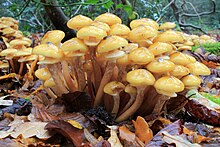| Armillaria | |
|---|---|

| |
| Armillaria mellea | |
| Scientific classification | |
| Domain: | Eukaryota |
| Kingdom: | Fungi |
| Division: | Basidiomycota |
| Class: | Agaricomycetes |
| Order: | Agaricales |
| Family: | Physalacriaceae |
| Genus: | Armillaria (Fr.) Staude |
| Type species | |
| Armillaria mellea (Vahl) P. Kumm.
| |
| Diversity | |
| c. 45 species | |
| Armillaria | |
|---|---|
| Gills on hymenium | |
| Cap is convex | |
| Hymenium is adnate | |
| Stipe has a ring | |
| Spore print is white | |
| Ecology is parasitic | |
| Edibility is edible | |
Armillaria is a genus of fungi that includes the A. mellea species known as honey fungi that live on trees and woody shrubs. It includes about 10 species formerly categorized summarily as A. mellea. Armillarias are long-lived and form the largest living fungi in the world.[1] The largest known organism (of the species Armillaria ostoyae) covers more than 3.4 square miles (8.8 km2) in Oregon's Malheur National Forest and is estimated to be 2,500 years old.[2][3] Some species of Armillaria display bioluminescence, resulting in foxfire.
Armillaria can be a destructive forest pathogen. It causes "white rot" root disease (see Plant pathology section) of forests, which distinguishes it from Tricholoma, a mycorrhizal (non-parasitic) genus. Because Armillaria is a facultative saprophyte, it also feeds on dead plant material, allowing it to kill its host, unlike parasites that must moderate their growth to avoid host death.[3]
- ^ Smith, Myron L.; Bruhn, Johann N.; Anderson, James B. (April 1992). "The fungus Armillaria bulbosa is among the largest and oldest living organisms". Nature. 356 (6368): 428–431. doi:10.1038/356428a0. ISSN 1476-4687.
- ^ John L. Ingraham (15 February 2010). March of the Microbes: Sighting the Unseen. Harvard University Press. p. 201. ISBN 978-0-674-03582-9.
- ^ a b Daley, Jason (15 October 2018). "This Humongous Fungus Is as Massive as Three Blue Whales". Smithsonian.com. Smithsonian Institution. Retrieved 21 October 2018.